Introduction to Claude monet – The Great
French Artist
Claude
Monet was the most dedicated and single-minded of the French Impressionists. He
was brought up on the Normandy coast, and the beautiful scenery there inspired
him to devote his life to landscape painting. Fired with a desire to capture
nature's most fleeting effects, he painted out-of-doors in all weathers. When
he moved to Paris he worked with the other great artists of his circle Renoir, Manet and Pissarro.
Today
Monet is almost universally admired, but at first he was misunderstood and
mocked. Estranged from his wealthy family, he endured misery and poverty in his
early career, and was in his forties before his work began to I ell. By the end
of Monet's long life he was a wealthy man and a revered artist, but success
never spoiled him. Even in his 80s he still worked tirelessly, despite his
failing eyesight.
The Pioneer from Normandy
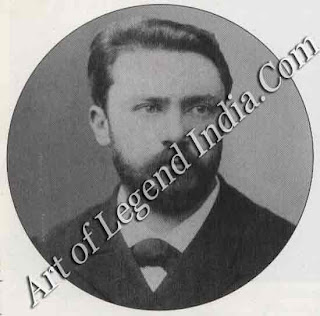 At the
age of 18, Monet left a prosperous family home in Le Havre for a bohemian life
in Paris. His willingness to sacrifice everything for his art had set the
pattern for his career.
At the
age of 18, Monet left a prosperous family home in Le Havre for a bohemian life
in Paris. His willingness to sacrifice everything for his art had set the
pattern for his career.
Claude-Oscar
Monet was born in Paris on 14 November 1840, the elder son of a grocer and
former sailor, Adolphe Monet. In 1845 Adolphe took over his family's
flourishing grocery and ship-chandlering business in Le Havre, and it was in
this busy port at the mouth of the River Seine that Claude (or Oscar, as his
family called him) spent most of his happy childhood and youth.
His
aunt, Sophie Lecadre, was an amateur painter and she no doubt encouraged the
talent for drawing he showed as a boy. When he should have been attending to
his lessons, Monet was often filling his books with caricatures, and by the
time he was 15 such drawings had won him a local reputation and his first
earnings as an artist.
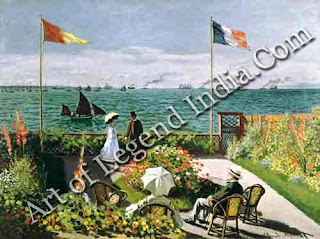 Monet's
drawings were displayed in the window of a local picture-framer's shop, and
this led to the great turning point in his life. The landscape painter Eugene
Boudin, a native of nearby Honfleur, also showed his work there, and when he
met Monet he took the young man (16 years his junior) under his wing and
encouraged him to paint alongside him. At this time most landscape paintings
were produced in the studio, but Boudin, a specialist in sea and beach scenes,
liked to paint in the open air, saying Everything that is painted directly and
on the spot always has a force, a power, a vivacity of touch that is not to be
found in studio work.'
Monet's
drawings were displayed in the window of a local picture-framer's shop, and
this led to the great turning point in his life. The landscape painter Eugene
Boudin, a native of nearby Honfleur, also showed his work there, and when he
met Monet he took the young man (16 years his junior) under his wing and
encouraged him to paint alongside him. At this time most landscape paintings
were produced in the studio, but Boudin, a specialist in sea and beach scenes,
liked to paint in the open air, saying Everything that is painted directly and
on the spot always has a force, a power, a vivacity of touch that is not to be
found in studio work.'
Monet
at first found Boudin's painting 'distasteful', but he was soon converted to
his friend's way of thinking, and in the summer of 1858, at the age of 17 he
found that landscape painting from nature was his true vocation. 'Suddenly a
veil was torn away. I had understood - I had realized what painting could be.
By the single example of this painter devoted to his art with such
independence, my destiny as a painter opened out to me.
A STUDENT IN PARIS
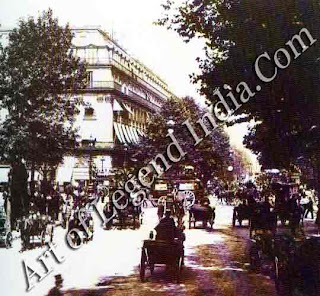 The
superb scenery of his Normandy home and the rapidly changing weather typical of
coastal areas provided ideal material for Monet's new-found love. But Paris -
the artistic capital not just of France but of the whole world was a lure for
all aspiring artists, and in 1859 Monet went there to pursue his studies, armed
with letters of introduction from Boudin and his aunt. His father wanted him to
study at the Ecole des Beaux-Arts, the official state school of art, but Monet
was always strongminded and self-confident and (3 preferred to study at the
Atelier Suisse. Named a; after its founder Charles Suisse, this was an g
independent academy where models were provided but there were no examinations
and no formal tuition. Monet's father cut off his allowance because of his
disobedience.
The
superb scenery of his Normandy home and the rapidly changing weather typical of
coastal areas provided ideal material for Monet's new-found love. But Paris -
the artistic capital not just of France but of the whole world was a lure for
all aspiring artists, and in 1859 Monet went there to pursue his studies, armed
with letters of introduction from Boudin and his aunt. His father wanted him to
study at the Ecole des Beaux-Arts, the official state school of art, but Monet
was always strongminded and self-confident and (3 preferred to study at the
Atelier Suisse. Named a; after its founder Charles Suisse, this was an g
independent academy where models were provided but there were no examinations
and no formal tuition. Monet's father cut off his allowance because of his
disobedience.
At the
Atelier Suisse, Monet met Camille Pissarro, who was to become one of the
central figures of the Impressionist movement, and he frequented the Brasserie
des Martyrs in Montmartre, a favourite meeting place of Gustave Courbet,
Edoulard Manet and other avant-garde A artists. Monet's growing involvement in
the agcultural life of Paris was halted when he was conscripted into the army,
and in 1861-62 he Served in Algeria. He developed anaemia and went to
convalesce at home, where his family offered to buy him out of the army if he
would undertake to study with an established painter.
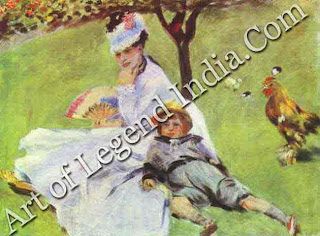 Monet
agreed, but before returning to Paris he met the Dutch painter Johan Barth°Id
Jongkind, who was working at Le Havre and who with Boudin was to be the great
mentor of Monet's early career. The novelist and critic Emile Zola wrote in
1868 of the astonishing breadth' and 'masterly simplifications of Jon kind’s
paintings, 'rapidly brushed for fear of losing the first impression', and in
1900 Monet said that he owed to him 'the definitive education of my eye'.
Monet
agreed, but before returning to Paris he met the Dutch painter Johan Barth°Id
Jongkind, who was working at Le Havre and who with Boudin was to be the great
mentor of Monet's early career. The novelist and critic Emile Zola wrote in
1868 of the astonishing breadth' and 'masterly simplifications of Jon kind’s
paintings, 'rapidly brushed for fear of losing the first impression', and in
1900 Monet said that he owed to him 'the definitive education of my eye'.
Key Dates
1840 born in Paris
1845 family moves to Le Havre
1858 meets
Eugene Boudin who encourages him to paint in the open air
1859 moves to’ Paris
1863 meets Renoir, Sisley and
Bazille
1867 his son Jean born to Camille
Doncieux
1870 marries Camille. Visits
England
1871 moves to Argenteuil
1874 first Impressionist
exhibition in Paris
1879 Camille dies
1883 settles at Giverny
1892 begins Rouen Cathedral
series. Marries Alice Hoschede
1900 enlarges waterlily pond
in his garden
1908 begins to suffer from
cataracts on eye
1911 Alice dies 1914 builds studio
for series of Waterlilies
1926 dies at Giverny
FINANCIAL PROBLEMS
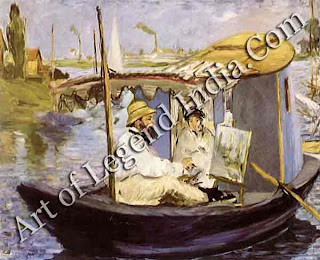 In 1862
Monet began to study at the Paris studio of Charles Gleyre, a successful
painter of conventional portraits and figure compositions. Monet was not happy
following the normal academic training of painting from the nude model, but as
his fellow-student Pierre-Auguste Renoir remarked, if Gleyre was 'of no help to
his pupils', he at least had the merit 'of leaving them pretty much to their
own devices'. Other students included Frederic Bazille and Alfred Sisley, who
with Monet and Renoir would evolve the Impressionist style of painting. They
painted together in the Forest of Fontainebleau, and Bazille, who came from a
wealthy family, helped Monet finandaily until his death in 1870.
In 1862
Monet began to study at the Paris studio of Charles Gleyre, a successful
painter of conventional portraits and figure compositions. Monet was not happy
following the normal academic training of painting from the nude model, but as
his fellow-student Pierre-Auguste Renoir remarked, if Gleyre was 'of no help to
his pupils', he at least had the merit 'of leaving them pretty much to their
own devices'. Other students included Frederic Bazille and Alfred Sisley, who
with Monet and Renoir would evolve the Impressionist style of painting. They
painted together in the Forest of Fontainebleau, and Bazille, who came from a
wealthy family, helped Monet finandaily until his death in 1870.
Gleyre
was forced to close his studio in 1864 because of an eye ailment and Monet's
family, dismayed at his bohemian lifestyle, again cut off his allowance. His
financial problems continued to be acute throughout the 1860s and even led to a
half-hearted attempt at suicide. In 1867 his mistress Camille, of whom his
family disapproved, gave birth to his son, and Monet, who was staying at SainteAdresse
near Le Havre, was so abjectly poor that he could not even raise the money to
go to Paris to see them.
 In 1870
Monet married Camille, but when war broke out between France and Prussia in the
same year, he left her with his son and went to England to avoid having to
fight. In London, where his family joined him later, Monet studied the work of
Constable and Turner and painted some views of parks and the River Thames, but
the most important aspect of his stay was meeting the French picture-dealer
Paul DurandRuel, who was the first dealer consistently to support the
Impressionists. Although Monet would still know poverty after DurandRuel began
buying his pictures, his life was no longer the tale of unremitting destitution
it had been through so much of the 1860s.
In 1870
Monet married Camille, but when war broke out between France and Prussia in the
same year, he left her with his son and went to England to avoid having to
fight. In London, where his family joined him later, Monet studied the work of
Constable and Turner and painted some views of parks and the River Thames, but
the most important aspect of his stay was meeting the French picture-dealer
Paul DurandRuel, who was the first dealer consistently to support the
Impressionists. Although Monet would still know poverty after DurandRuel began
buying his pictures, his life was no longer the tale of unremitting destitution
it had been through so much of the 1860s.
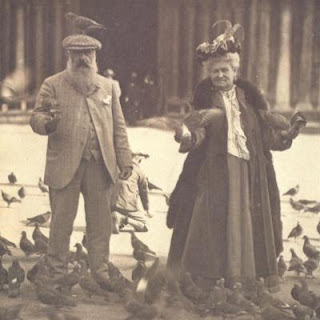 In 1871
Monet returned to France via Holland and rented a house at Argenteuil, a
village on the Seine a few miles from Paris. This was one of the most fruitful
periods in Monet's life: he was happily married and comparatively prosperous
(Camille inherited some money in 1873), and the pleasures of life on the river
and along its banks provided him with an abundance of subjects. His friends
often visited him, and the bridges and boats of Argenteuil appear again and
again in the Impressionist paintings of Renoir and Sisley.
In 1871
Monet returned to France via Holland and rented a house at Argenteuil, a
village on the Seine a few miles from Paris. This was one of the most fruitful
periods in Monet's life: he was happily married and comparatively prosperous
(Camille inherited some money in 1873), and the pleasures of life on the river
and along its banks provided him with an abundance of subjects. His friends
often visited him, and the bridges and boats of Argenteuil appear again and
again in the Impressionist paintings of Renoir and Sisley.
CAMILLE'S DEATH
It was
at this period that the Impressionists were most united and in 1874 they held
their first exhibition as a group. The show was a commercial failure, as was a
group sale in the following year, and when debts began to mount, Monet's
idyllic Argenteuil period drew to a close. In 1878 he moved to Vetheuil, still
on the Seine, but farther from Paris, and in 1879 Camille died after a long
illness. Monet's burden of grief and responsibility (by now he had a second
son) was eased by a woman called Alice Hoschede, the wife of a collector of
Impressionist paintings, with whom Monet had begun an affair in 1876. She
nursed Camille, looked after the children and assumed Monet's debts. Monet
eventually married her in 1892 after she had become a widow.
In the
next few years Monet moved to various places, including Dieppe, Pourville and
Varengeville, all on the Normandy coast. Then in 1883 he finally settled at
Giverny, about 40 miles from Paris, on the River Epte, with Madame Hoschede,
his children and her children. By this time the original Impressionist group
had virtually broken up, and only Monet continued to pursue the Impressionist ideal
the acute scrutiny of nature.
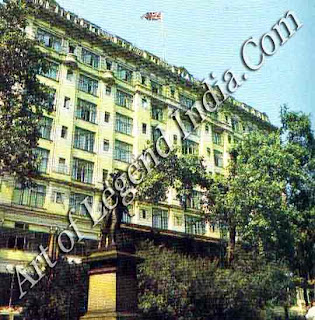
Monet
now had a settled home, but his tremendous energy led him to travel widely in
search of subjects, and in the 1880s he worked extensively on the Mediterranean
coast as well as in Brittany and Normandy; he also visited Holland and Italy.
In the same decade his reputation began to grow and his fortunes to prosper,
thanks in great measure to the efforts of DurandRuel, who in 1883 alone organized
exhibitions of Impressionist paintings in Berlin, Boston, London and Rotterdam.
By 1890 Monet was secure enough financially to buy the house at Giverny he had
previously rented, and in 1891 an exhibition of his paintings at DurandRuel's
gallery in Paris sold out only three days after opening. All the paintings at
this exhibition were of haystacks, and this marked the beginning of the most
original feature of Monet's later career the production of several series of
paintings in which he represented the same subject d't different times of the
day under different lighting conditions. Monet spent much of his time in his
studio developing these series for although he still loved painting out of
doors, he now realized that he could more easily obtain the effects he wanted when he had time to reflect away from the subject.
MONET THE GARDENER
As he
advanced in years, Monet continued to travel; he visited Norway in 1895 as the
guest ofQueen Christiana, London three times between 1899 and 1904, Madrid in
1904 and Venice in 1908 and 1909. However, his attention was focused mainly on Give
my, and particularly on one part of his home the water garden that he had
developed during the 1890s on a strip of marshland next to his house. Monet had
diverted a stream through it and created an exotic world of weeping willows,
bamboo and floating lilies. He began painting the garden in about 1899, and
from about 1906 it became the centre of his artistic life, for in the water
lilies, with their ever-changing patterns of colour and light, he had found an
inexhaustible subject: 'my pond had become enchanted'. The first paintings of
the garden were about three feet square, but they became larger as Monet's
absorption increased, and in 1914 he had a special studio built so he could
work on a huge scale. His wife had died three years earlier, but he had the
love of his devoted step-daughter, Blanche Hoschede-Monet, herself a painter,
to support him, and he worked with unflagging energy.
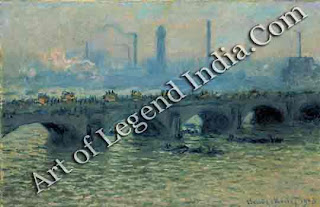 By this
time Monet was the grand old man of French painting, and it was at the
suggestion of the Prime Minister, Georges Clemenceau, one of the many
distinguished visitors to Give my, that he decided to present several of his
waterlily paintings to the nation in the form of an enormous decorative scheme.
Monet's sight was failing, his work on the paintings was delayed while he had a
cataract operation, and he did not live to see their unveiling in the Orangerie
in Paris (part of the Louvre complex) on 17 May 1927. He died aged 86, on 5
December 1926 at Give my and was buried beside the small village church. In the
last year of his life, Monet described his aim as being `to render my
impressions in front of the most fleeting effects', words he could equally have
used at any stage during more than half a century of ceaseless creativity.
By this
time Monet was the grand old man of French painting, and it was at the
suggestion of the Prime Minister, Georges Clemenceau, one of the many
distinguished visitors to Give my, that he decided to present several of his
waterlily paintings to the nation in the form of an enormous decorative scheme.
Monet's sight was failing, his work on the paintings was delayed while he had a
cataract operation, and he did not live to see their unveiling in the Orangerie
in Paris (part of the Louvre complex) on 17 May 1927. He died aged 86, on 5
December 1926 at Give my and was buried beside the small village church. In the
last year of his life, Monet described his aim as being `to render my
impressions in front of the most fleeting effects', words he could equally have
used at any stage during more than half a century of ceaseless creativity.
Writer-A Marshall Cavendish
 At the
age of 18, Monet left a prosperous family home in Le Havre for a bohemian life
in Paris. His willingness to sacrifice everything for his art had set the
pattern for his career.
At the
age of 18, Monet left a prosperous family home in Le Havre for a bohemian life
in Paris. His willingness to sacrifice everything for his art had set the
pattern for his career.  Monet's
drawings were displayed in the window of a local picture-framer's shop, and
this led to the great turning point in his life. The landscape painter Eugene
Boudin, a native of nearby Honfleur, also showed his work there, and when he
met Monet he took the young man (16 years his junior) under his wing and
encouraged him to paint alongside him. At this time most landscape paintings
were produced in the studio, but Boudin, a specialist in sea and beach scenes,
liked to paint in the open air, saying Everything that is painted directly and
on the spot always has a force, a power, a vivacity of touch that is not to be
found in studio work.'
Monet's
drawings were displayed in the window of a local picture-framer's shop, and
this led to the great turning point in his life. The landscape painter Eugene
Boudin, a native of nearby Honfleur, also showed his work there, and when he
met Monet he took the young man (16 years his junior) under his wing and
encouraged him to paint alongside him. At this time most landscape paintings
were produced in the studio, but Boudin, a specialist in sea and beach scenes,
liked to paint in the open air, saying Everything that is painted directly and
on the spot always has a force, a power, a vivacity of touch that is not to be
found in studio work.'  The
superb scenery of his Normandy home and the rapidly changing weather typical of
coastal areas provided ideal material for Monet's new-found love. But Paris -
the artistic capital not just of France but of the whole world was a lure for
all aspiring artists, and in 1859 Monet went there to pursue his studies, armed
with letters of introduction from Boudin and his aunt. His father wanted him to
study at the Ecole des Beaux-Arts, the official state school of art, but Monet
was always strongminded and self-confident and (3 preferred to study at the
Atelier Suisse. Named a; after its founder Charles Suisse, this was an g
independent academy where models were provided but there were no examinations
and no formal tuition. Monet's father cut off his allowance because of his
disobedience.
The
superb scenery of his Normandy home and the rapidly changing weather typical of
coastal areas provided ideal material for Monet's new-found love. But Paris -
the artistic capital not just of France but of the whole world was a lure for
all aspiring artists, and in 1859 Monet went there to pursue his studies, armed
with letters of introduction from Boudin and his aunt. His father wanted him to
study at the Ecole des Beaux-Arts, the official state school of art, but Monet
was always strongminded and self-confident and (3 preferred to study at the
Atelier Suisse. Named a; after its founder Charles Suisse, this was an g
independent academy where models were provided but there were no examinations
and no formal tuition. Monet's father cut off his allowance because of his
disobedience.  Monet
agreed, but before returning to Paris he met the Dutch painter Johan Barth°Id
Jongkind, who was working at Le Havre and who with Boudin was to be the great
mentor of Monet's early career. The novelist and critic Emile Zola wrote in
1868 of the astonishing breadth' and 'masterly simplifications of Jon kind’s
paintings, 'rapidly brushed for fear of losing the first impression', and in
1900 Monet said that he owed to him 'the definitive education of my eye'.
Monet
agreed, but before returning to Paris he met the Dutch painter Johan Barth°Id
Jongkind, who was working at Le Havre and who with Boudin was to be the great
mentor of Monet's early career. The novelist and critic Emile Zola wrote in
1868 of the astonishing breadth' and 'masterly simplifications of Jon kind’s
paintings, 'rapidly brushed for fear of losing the first impression', and in
1900 Monet said that he owed to him 'the definitive education of my eye'.  In 1862
Monet began to study at the Paris studio of Charles Gleyre, a successful
painter of conventional portraits and figure compositions. Monet was not happy
following the normal academic training of painting from the nude model, but as
his fellow-student Pierre-Auguste Renoir remarked, if Gleyre was 'of no help to
his pupils', he at least had the merit 'of leaving them pretty much to their
own devices'. Other students included Frederic Bazille and Alfred Sisley, who
with Monet and Renoir would evolve the Impressionist style of painting. They
painted together in the Forest of Fontainebleau, and Bazille, who came from a
wealthy family, helped Monet finandaily until his death in 1870.
In 1862
Monet began to study at the Paris studio of Charles Gleyre, a successful
painter of conventional portraits and figure compositions. Monet was not happy
following the normal academic training of painting from the nude model, but as
his fellow-student Pierre-Auguste Renoir remarked, if Gleyre was 'of no help to
his pupils', he at least had the merit 'of leaving them pretty much to their
own devices'. Other students included Frederic Bazille and Alfred Sisley, who
with Monet and Renoir would evolve the Impressionist style of painting. They
painted together in the Forest of Fontainebleau, and Bazille, who came from a
wealthy family, helped Monet finandaily until his death in 1870.  In 1870
Monet married Camille, but when war broke out between France and Prussia in the
same year, he left her with his son and went to England to avoid having to
fight. In London, where his family joined him later, Monet studied the work of
Constable and Turner and painted some views of parks and the River Thames, but
the most important aspect of his stay was meeting the French picture-dealer
Paul DurandRuel, who was the first dealer consistently to support the
Impressionists. Although Monet would still know poverty after DurandRuel began
buying his pictures, his life was no longer the tale of unremitting destitution
it had been through so much of the 1860s.
In 1870
Monet married Camille, but when war broke out between France and Prussia in the
same year, he left her with his son and went to England to avoid having to
fight. In London, where his family joined him later, Monet studied the work of
Constable and Turner and painted some views of parks and the River Thames, but
the most important aspect of his stay was meeting the French picture-dealer
Paul DurandRuel, who was the first dealer consistently to support the
Impressionists. Although Monet would still know poverty after DurandRuel began
buying his pictures, his life was no longer the tale of unremitting destitution
it had been through so much of the 1860s. In 1871
Monet returned to France via Holland and rented a house at Argenteuil, a
village on the Seine a few miles from Paris. This was one of the most fruitful
periods in Monet's life: he was happily married and comparatively prosperous
(Camille inherited some money in 1873), and the pleasures of life on the river
and along its banks provided him with an abundance of subjects. His friends
often visited him, and the bridges and boats of Argenteuil appear again and
again in the Impressionist paintings of Renoir and Sisley.
In 1871
Monet returned to France via Holland and rented a house at Argenteuil, a
village on the Seine a few miles from Paris. This was one of the most fruitful
periods in Monet's life: he was happily married and comparatively prosperous
(Camille inherited some money in 1873), and the pleasures of life on the river
and along its banks provided him with an abundance of subjects. His friends
often visited him, and the bridges and boats of Argenteuil appear again and
again in the Impressionist paintings of Renoir and Sisley.  By this
time Monet was the grand old man of French painting, and it was at the
suggestion of the Prime Minister, Georges Clemenceau, one of the many
distinguished visitors to Give my, that he decided to present several of his
waterlily paintings to the nation in the form of an enormous decorative scheme.
Monet's sight was failing, his work on the paintings was delayed while he had a
cataract operation, and he did not live to see their unveiling in the Orangerie
in Paris (part of the Louvre complex) on 17 May 1927. He died aged 86, on 5
December 1926 at Give my and was buried beside the small village church. In the
last year of his life, Monet described his aim as being `to render my
impressions in front of the most fleeting effects', words he could equally have
used at any stage during more than half a century of ceaseless creativity.
By this
time Monet was the grand old man of French painting, and it was at the
suggestion of the Prime Minister, Georges Clemenceau, one of the many
distinguished visitors to Give my, that he decided to present several of his
waterlily paintings to the nation in the form of an enormous decorative scheme.
Monet's sight was failing, his work on the paintings was delayed while he had a
cataract operation, and he did not live to see their unveiling in the Orangerie
in Paris (part of the Louvre complex) on 17 May 1927. He died aged 86, on 5
December 1926 at Give my and was buried beside the small village church. In the
last year of his life, Monet described his aim as being `to render my
impressions in front of the most fleeting effects', words he could equally have
used at any stage during more than half a century of ceaseless creativity. 
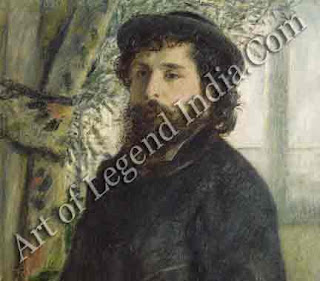











0 Response to "Introduction to Claude monet – The Great French Artist"
Post a Comment